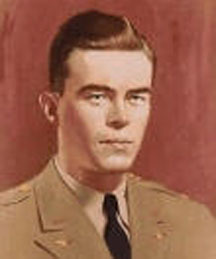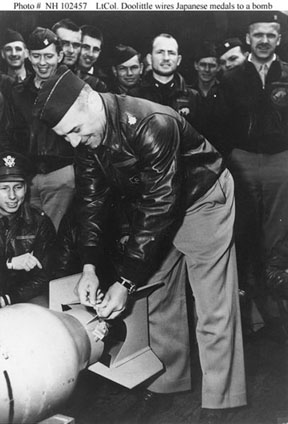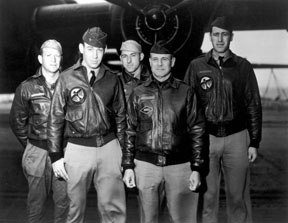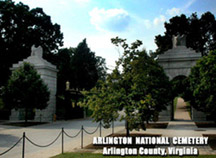Jimmy
Doolittle's Raid
|
On April 18, 1942, Lt. Col. James H. "Jimmy" Doolittle set out to do just that! He led sixteen B-25 medium bombers to the heart of Japan including Tokyo. Afterwards they were to fly to China and turn their aircraft over to new Air Forces units being organized.
|
The fleet was spotted some 200 miles short of the planned launch point. The simple act of launching Air Forces bombers from a carrier (USS Hornet) was near impossible but having to launch 200 miles earlier than planned further complicated the mission. The mission went well but the early launch insured that all would be unable to reach China as planned. Fifteen headed for China. One headed for Russia and landed at Vladivostok. They were interned but escaped through Iran fourteen months later. The planes were never returned by The Soviets. All the rest had to bail out or ditch in the water as their fuel tanks emptied. Two drowned swimming ashore, one was killed in the bail out, four were seriously injured during the ditching, Eight were captured by the Japanese who executed three and let another die of malnutrition. The remaining four captured by the |
But what happened to Jimmy Doolittle and his crew? They bailed out safely. They were rescued by sympathetic Chinese and smuggled by river into Zhejiang province. An American missionary was told of the survivors, and went to meet them. He assisted them in getting to safety, and then helped locate and direct other American crews to friendly territory. The Chinese people who helped them, however, paid dearly for it. The Japanese killed an estimated 250,000 civilians while searching for Doolittle's men.
|
When Doolittle arrived safely in Chongqing, he told Colonel Claire Chennault, leader of the Flying Tigers, about the young missionary and his help. Chennault wanted an American for intelligence duties who could speak Chinese and knew the country. Chennault commissioned him as a First Lieutenant, although he said in a book later that he was willing to be put in as a |
 John Birch |
He was later moved to the American OSS. He agreed stating he would only be willing if the OSS agreed that he be allowed to continue his work. He built a formidable intelligence network of sympathetic Chinese informants, supplying Chennault with information on Japanese troop movements and shipping, often performing dangerous incognito field assignments during which he would brazenly hold Sunday church services for Chinese Christians. Urged to take a leave of absence, he refused, telling Chennault he would not quit China "until the last Jap"; he was equally contemptuous of Communists. He was promoted to Captain, and received the Legion of Merit in 1944.
|
August 14, 1945, V-J Day was the end of hostilities for America, but China was still in ferment. On August 25, as he was leading a party of Americans, Chinese Nationalists, and Koreans on a mission to reach Allied personnel in a Japanese prison camp, they were stopped by Chinese Communists near Xi'an. He was told to disarm; he refused and was shot and killed; The rest of the party was imprisoned but released a short time later. John Birch was posthumously awarded a Distinguished Service Medal. You have heard his name many times before
but only of the Society that chose his name. They chose his name
because he was the first American to lose his life in the Cold War. |
John Birch is known today only by the society that bears his name except for the people in Macon Georgia. His name is on the bronze plaque of a World War II monument at the top of Coleman Hill Park overlooking downtown, along with the names of other Macon men who lost their lives while serving in the military. Birch has a plaque on the sanctuary of the First Southern Methodist Church of Macon. A building at the First Baptist Church of Fort Worth, Texas, is named The John Birch Hall. A small street in a housing development outside Boston is also named for him.
|
|
I
am John Birch's great niece. And, I was reading your article on "The
Rest of the Story" - at the end you say he is buried in Arlington
Cemetery. Sadly, that is not the truth. John's remains were never
returned to the US and as far as we know, they are still interred
on that hillside in Suchow, China, under a monument that reads in
Chinese: "He died for righteousness."
Just thought you would like to know! Thank you, Ashley |
References and further reading on the subject.
Doolittle Tokyo Raiders Online
http://www.doolittletokyoraiders.com
Wikipedia, the free encyclopedia
http://en.wikipedia.org/wiki/Doolittle_raid
USS Enterprise CV-6
http://www.cv6.org/1942/doolittle/doolittle.htm
The Doolittle Tokyo Raiders
http://www.doolittleraider.com/
Answers.com
http://www.answers.com/
John Birch Society
http://www.jbs.org/
Thanks to Find
a Grave for images
http://www.findagrave.com/cgi-bin/fg.cgi?page=gr&GRid=6360481
|
Visitors since
June 6, 2000 |


